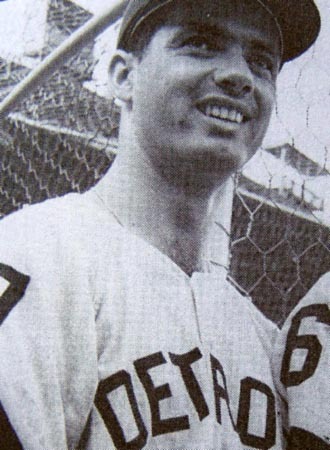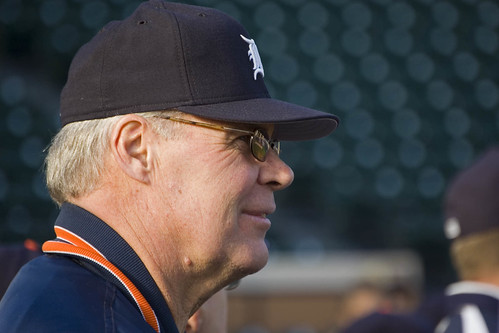Colavito's Arm Rivaled His Power At The Plate
The question came to me, quite out of the blue, but it made me smile nonetheless.
One of my colleagues at Bleacher Report had read one of my nostalgic Tigers pieces--the kind I'm so wont to do, as you know--and we started a back-and-forth chat about great players of the past, including non-Tigers.
Then, this.
"Who had the better arm? Clemente or Colavito?," he asked.
Ahh yes. Thanks for asking!
It's pretty much commonly known that Roberto Clemente had one of the finest arms ever in baseball history. A virtual cannon in right field.
I can still see the one throw, from the 1971 World Series.
Clemente turning and throwing, in one motion, and delivering a laser to third base, from deep in the right field corner. The ball never was more than five feet off the ground.
OK, so we know about Clemente, but where did Rocky Colavito's invocation come from?
Colavito, a Tiger from 1960-63, gave the team two howitzers in the outfield.
Don't forget about Al Kaline!
Kaline, in my opinion, was just a notch below Clemente in the arm department. Maybe half a notch, on second thought.
Kaline's throwing was based largely on his impeccable form. No one mastered the art of the catch-and-throw like Kaline.
If a runner dared to try to score from third base on a flyball to right field against Kaline, it was far from a sure thing, no matter how deep the ball was hit.
Kaline's footwork as he waited for the ball to arrive in his mitt was where his accuracy and strength originated. He'd circle gently, gauging the ball's trajectory, then position himself perfectly so that he could make the catch and the throw in one motion.
No one did that better than Al Kaline. Not even Clemente.
Ah, but what of Colavito?

Colavito could bring it from the outfield--right or left
Rock is normally known in baseball for being the home run champ who was traded for a batting champ. The Tigers and the Indians swung that deal, on the eve of the 1960 season: Colavito for Harvey Kuenn.
But Colavito was more than just a power hitter. His arm was so good that the Tigers moved Kaline to center field and put Rock in right in 1960.
But then the idea was hatched to switch Rock to left field and return Kaline to right, starting in 1961. They pretty much played that way from '61-'63.
If Colavito's arm was one of the best in right field--and it was--then it was terribly over-qualified for left field.
But opposing base runners ran at their own risk against the Tigers in those days, with Kaline and Colavito patrolling the outfield corners.
Rock was traded by Detroit to the Kansas City A's, then became somewhat of a journeyman as his power mysteriously waned. A New York kid, Rock finished with the Yankees in '68.
With the Tigers, Rock slammed 139 homers in four seasons.
He also recorded 61 outfield assists in those four years, and 123 for his career. By comparison, Kaline had 170 outfield assists, and Clemente an amazing 266.
So how did I answer the question, asking about the arms of Clemente and Colavito?
Clemente, of course--but Rock was no slouch. Not at all.
One of my colleagues at Bleacher Report had read one of my nostalgic Tigers pieces--the kind I'm so wont to do, as you know--and we started a back-and-forth chat about great players of the past, including non-Tigers.
Then, this.
"Who had the better arm? Clemente or Colavito?," he asked.
Ahh yes. Thanks for asking!
It's pretty much commonly known that Roberto Clemente had one of the finest arms ever in baseball history. A virtual cannon in right field.
I can still see the one throw, from the 1971 World Series.
Clemente turning and throwing, in one motion, and delivering a laser to third base, from deep in the right field corner. The ball never was more than five feet off the ground.
OK, so we know about Clemente, but where did Rocky Colavito's invocation come from?
Colavito, a Tiger from 1960-63, gave the team two howitzers in the outfield.
Don't forget about Al Kaline!
Kaline, in my opinion, was just a notch below Clemente in the arm department. Maybe half a notch, on second thought.
Kaline's throwing was based largely on his impeccable form. No one mastered the art of the catch-and-throw like Kaline.
If a runner dared to try to score from third base on a flyball to right field against Kaline, it was far from a sure thing, no matter how deep the ball was hit.
Kaline's footwork as he waited for the ball to arrive in his mitt was where his accuracy and strength originated. He'd circle gently, gauging the ball's trajectory, then position himself perfectly so that he could make the catch and the throw in one motion.
No one did that better than Al Kaline. Not even Clemente.
Ah, but what of Colavito?

Colavito could bring it from the outfield--right or left
Rock is normally known in baseball for being the home run champ who was traded for a batting champ. The Tigers and the Indians swung that deal, on the eve of the 1960 season: Colavito for Harvey Kuenn.
But Colavito was more than just a power hitter. His arm was so good that the Tigers moved Kaline to center field and put Rock in right in 1960.
But then the idea was hatched to switch Rock to left field and return Kaline to right, starting in 1961. They pretty much played that way from '61-'63.
If Colavito's arm was one of the best in right field--and it was--then it was terribly over-qualified for left field.
But opposing base runners ran at their own risk against the Tigers in those days, with Kaline and Colavito patrolling the outfield corners.
Rock was traded by Detroit to the Kansas City A's, then became somewhat of a journeyman as his power mysteriously waned. A New York kid, Rock finished with the Yankees in '68.
With the Tigers, Rock slammed 139 homers in four seasons.
He also recorded 61 outfield assists in those four years, and 123 for his career. By comparison, Kaline had 170 outfield assists, and Clemente an amazing 266.
So how did I answer the question, asking about the arms of Clemente and Colavito?
Clemente, of course--but Rock was no slouch. Not at all.










 Proud Member of DIBS
Proud Member of DIBS

0 Comments:
Post a Comment
<< Home